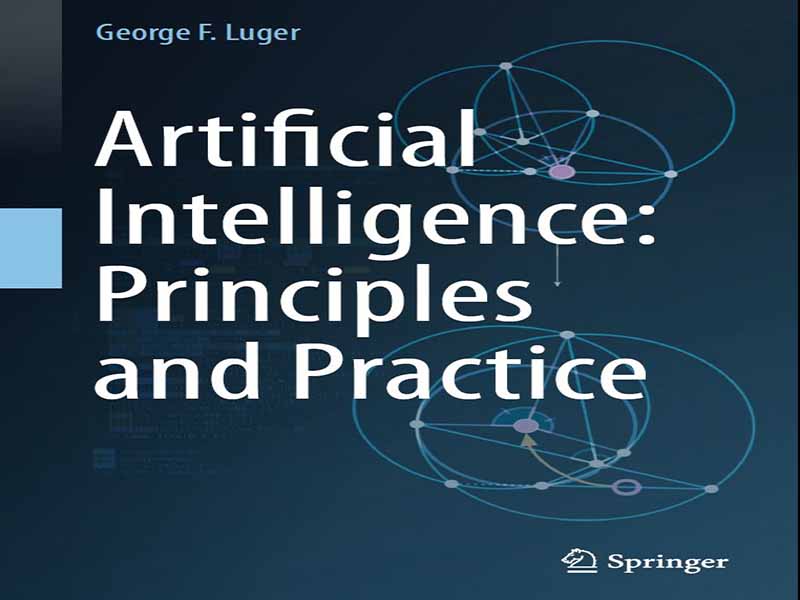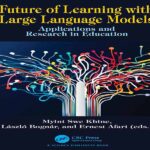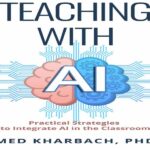- عنوان کتاب: Artificial Intelligence: Principles and Practice
- نویسنده: George F. Luger
- حوزه: مبانی هوش مصنوعی
- سال انتشار: 2025
- تعداد صفحه: 639
- زبان اصلی: انگلیسی
- نوع فایل: pdf
- حجم فایل: 10.7 مگابایت
این کتاب مقدمه ای جامع بر رشته هیجان انگیز و اغلب مرموز هوش مصنوعی ارائه می دهد. به عنوان مقدمهای بر هوش مصنوعی، فناوریهای محاسباتی اساسی را پوشش میدهد که از زمان آغاز به کار هوش مصنوعی در بیش از 70 سال پیش، از کار در هوش مصنوعی پشتیبانی میکنند. در بخش اول، رشتههای ریاضی، فلسفی و مهندسی را پوشش میدهد که هوش مصنوعی را ممکن میسازد. هوش مصنوعی یک رشته مستقل نیست، بلکه بینش های بسیاری از روانشناسان، ریاضیدانان، دانشمندان علوم اعصاب و دیگران را که بخشی از تحقیقات و عملکرد فعلی آن هستند، ادغام و گسترش می دهد. فصل پایانی، قسمت هشتم، بر محدودیتها، مسائل اخلاقی و وعدههای آینده هوش مصنوعی تمرکز دارد. در اینجا ما بسیاری از مسائل اجتماعی را که باید هنگام ادغام فناوری هوش مصنوعی در دنیای مدرن در نظر گرفته شوند، ارائه می کنیم. سه پارادایم اصلی طراحی وجود دارد که در تحقیقات و مهندسی هوش مصنوعی در 70 سال گذشته ظهور کرده است. اولین پارادایم، که در دهه 1950 آغاز شد، رویکرد مبتنی بر نماد برای حل مسئله است. هوش مصنوعی مبتنی بر نماد مبتنی بر نظریه گراف، الگوریتمهای جستجو و استفاده از تکنیکهای بازنمایی از جمله شبکههای معنایی و محاسبات گزارهای و محمول است. این فناوریها در بخشهای II تا V پوشش داده شدهاند. الگوی دوم تمرین هوش مصنوعی، حل مشکل شبکه عصبی یا اتصالگرا است. اگرچه این سنت ریشه در دهه 1940 داشت و در مانیفست هوش مصنوعی ساخته شده در کارگاه تابستانی دارتموث در سال 1956 ذکر شد، اما تا زمان ایجاد ماشین بولتزمن و الگوریتمهای انتشار پسانداز در دهههای 1970 و 1980 به پتانسیل کامل خود نرسید (Werbos 1994; C Rumellhart 1994). از آن زمان، شبکههای عصبی و یادگیری عمیق نتایج با کیفیت زیادی در پردازش تصویر، تجزیه و تحلیل زبان انسان و سایر زمینههای پردازش اطلاعات پیچیده ایجاد کردهاند. حل مسئله شبکه عصبی، با مقدمه ای بر یادگیری عمیق، در شش فصل از قسمت ششم پوشش داده شده است. رویکردهای احتمالی یا تصادفی برای حل مسئله، سومین پارادایم اصلی هوش مصنوعی را تشکیل می دهند. این رویکرد از معیارهای احتمال مبتنی بر بیزی برای رسیدگی به عدم قطعیت ها و عدم دقت موقعیت های جهانی استفاده می کند. هوش مصنوعی احتمالی در مطالعات تشخیص رقم و تصویر در دهه 1950 آغاز شد، اما تنها با موفقیت در پردازش زبان انسانی در دهه 1990 به پذیرش در مقیاس بزرگ رسید. بینش پرل (1988، 2000) که در ایجاد شبکههای باور بیزی و شبکههای پویا بیزی دیده میشود، به بسیاری از اشکال استدلال بیزی اجازه داد که از نظر محاسباتی قابل پردازش، شفافتر و پاسخگوتر به کاربر باشند. مدلهای احتمالی در بخش هفتم ارائه شدهاند. پارادایمهای جزئی دیگری نیز وجود دارند که کاربرد بسیار محدودتری در عملکرد فعلی هوش مصنوعی دارند. اینها شامل الگوریتم های ژنتیک، زندگی مصنوعی، فازی و سایر اشکال مبتنی بر منطق برای استدلال نامطمئن است. الگوریتم های ژنتیک، پیشنهاد شده توسط هالند در دهه 1970، و محاسبات اضطراری، که برای اولین بار توسط فون نومان در دهه 1940 ارائه شد، بینش داروین را در مورد رشد جمعیت و بقای شایسته ترین اعضای یک جامعه منعکس می کند. این تکنیک ها در بخش های فرعی قسمت دوم ارائه شده اند. طرحهای فازی و دیگر طرحهای مبتنی بر منطق برای استدلال در موقعیتهای نامشخص در فصل 7 ارائه شدهاند. 12. اصول و عملکرد این پارادایم ها شالوده و موفقیت های کار در هوش مصنوعی فعلی را تشکیل می دهند. آنها همچنین ساختار و کاربردهای توصیه شده مواد درسی ما را منعکس می کنند.
This book offers a comprehensive introduction to the exciting and too often mysterious discipline of Artificial Intelligence. As an introduction to AI, it covers the foundational computational technologies that have supported work in AI since its inception over 70 years ago. In Part I, it covers the mathematical, philosophical, and engineering disciplines that make artificial intelligence possible. AI is not a standalone discipline but rather integrates and expands the many insights of the psychologists, mathematicians, neuroscientists, and others that are part of its current research and practice. The final chapters, Part VIII, focus on the limitations, ethical issues, and future promise of AI. Here we present many of the social issues that must be considered when integrating AI technology into our modern world. There are three major design paradigms that have emerged in AI research and engineering over the past 70 years. The first paradigm, begun in the 1950s, is the symbol-based approach to problem-solving. Symbol-based AI is founded on graph theory, search algorithms, and the use of representational techniques including semantic networks and the propositional and predicate calculi. These technologies are covered in Parts II through V. The second paradigm of AI practice is neural or connectionist network problem-solving. Although this tradition had its roots in the 1940s and was mentioned in the AI manifesto made at the Dartmouth summer workshop in 1956, it did not reach its full potential until the creation of the Boltzmann machine and the backpropagation algorithms of the 1970s and 1980s (Werbos 1994; Rumelhart and McClelland 1986). Since then, neural networks and deep learning have produced many quality results in image processing, human language analysis, and other areas of complex information processing. Neural network problem-solving, with an introduction to deep learning, is covered in the six chapters of Part VI. Probabilistic or stochastic approaches to problem-solving make up the third major paradigm of AI. This approach uses Bayesian-based probability measures to address the uncertainties and impreciseness of world situations. Probabilistic AI began in the digit and image recognition studies of the 1950s, but only reached large-scale acceptance with successes in human language processing of the 1990s. Pearl’s (1988, 2000) insights, seen in the creation of Bayesian belief networks and dynamic Bayesian networks, allowed the many forms of Bayesian reasoning to be computationally tractable, more transparent, and accountable to the user. Probabilistic models are presented in Part VII. There are other minor paradigms, with much more limited use in current AI practice. These include genetic algorithms, artificial life, fuzzy and other logic-based forms for uncertain reasoning. Genetic algorithms, suggested by Holland in the 1970s, and emergent computation, first proposed by von Neu-mann in the 1940s, reflect Darwin’s insights on population growth and survival of the fittest members of a society. These techniques are presented in subsections of Part II. Fuzzy and other logic-based schemes for reasoning in uncertain situations are presented in 7 Chap. 12. The principles and practice of these paradigms make up the foundation and successes of work in current artificial intelli-gence. They also reflect the structure and the recommended uses of our course materials.
این کتاب را میتوانید از لینک زیر بصورت رایگان دانلود کنید:




































نظرات کاربران